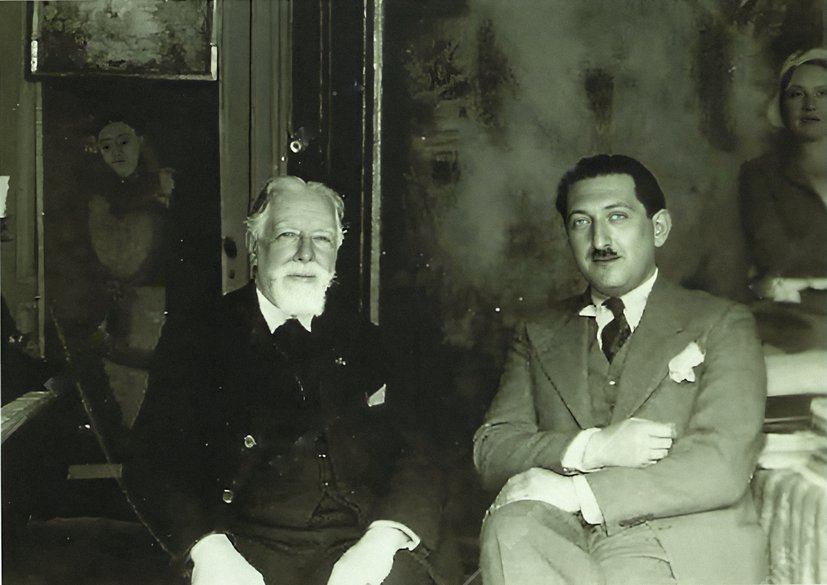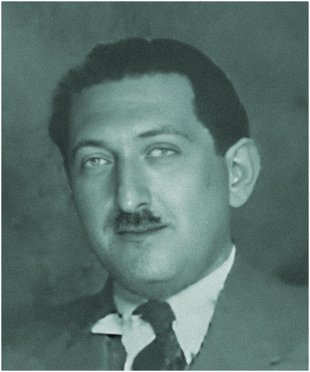Carol Deutsch
1894-1944
Carol Deutsch was a Belgian-Jewish painter whose life was cut short during the Holocaust. He became known for his expressionist paintings and, ultimately, for a remarkable collection of biblical illustrations created during the darkest period of his life.
Deutsch was born in Antwerp on May 21, 1894 as the third son of Simon Deutsch, a diamond dealer of Hungarian-Jewish descent, and Hermina Ratzersdorfer from Vienna. After his mother died of influenza in 1895, his father remarried and had two more sons. The family provided Deutsch with an Orthodox Jewish education, and he initially worked in his father's diamond business.
In 1922, Deutsch married Esther Lauffer, daughter of an Ostend fur trader, and the couple moved to Ostend where they opened a fur business. While his wife managed the shop, Deutsch became immersed in the city's artistic scene. Despite having no formal art training, he caught the attention of James Ensor, the prominent Belgian artist, who recognized his talent and became his teacher and friend.

Ensor painted Deutsch's portrait in 1928 and wrote the introduction to his first solo exhibition catalogue in 1929. Deutsch quickly became part of Ostend's artistic circle, which included Léon Spilliaert and Constant Permeke, whose influences can be seen in his early expressionist works featuring landscapes and robust human figures.
By 1929, Deutsch had become chairman of Ostend's Jewish community. However, his 1930 exhibition at the Kursaal caused controversy due to its provocative nudes, nearly resulting in his excommunication from the Jewish authorities. This scandal marked a turning point in his subject matter, leading him to focus primarily on architectural cityscapes and portraits.
In 1934, at his final solo exhibition in Brussels, Deutsch met Fela Bronsztajn, a Polish woman seventeen years his junior who was a second cousin of Leon Trotsky. Their romance led to the end of his marriage to Esther and caused a rift with his mentor Ensor, who disapproved of the relationship.
Facing personal and financial difficulties, Deutsch travelled to Mandate Palestine in 1935-1936, where he painted landscapes and cityscapes depicting the Mediterranean light and ancient landscapes of the Holy Land. He returned to Belgium in December 1936 and divorced his first wife. In December 1938, he married Fela, and their daughter Ingrid was born in January 1940.
War Years and Desperation
When Nazi Germany invaded Belgium in May 1940, the Deutsch family's home in Antwerp was destroyed in the bombardment. Deutsch attempted unsuccessfully to obtain visas to emigrate to the United States. The family was forced to relocate multiple times as anti-Jewish restrictions tightened.
During this period of extreme hardship, Deutsch embarked on what would become his most significant work. Between 1941 and 1942, while living under the constant threat of deportation, he created 99 gouache illustrations depicting biblical narratives and protagonists. He completed this collection as a gift for his daughter Ingrid's second birthday, carefully preserving the illustrations in an ornamental wooden box that he designed himself, adorned with a Star of David and a seven-branched menorah.
The biblical illustrations combined Art Nouveau ornamentation with stylistic influences from the Bezalel School, reflecting his 1936 visit to Mandate Palestine. Unlike many European artists of his time, Deutsch placed his biblical figures in their native Middle Eastern settings, illuminated by what he saw as the special light of the Holy Land.
On September 3, 1943, Deutsch and Fela were betrayed and arrested by the Gestapo. When Fela attempted to secure his release, she too was arrested. Their two-year-old daughter Ingrid and her grandmother Regina Braunstein managed to hide with a Catholic family in Florenville, a town in southeastern Belgium, where they survived the war under assumed identities.
On September 20, 1943, Deutsch and his wife were deported from the Mechelen transit camp to Auschwitz on transport 22-B, registered as prisoners 96B and 97B. Fela was murdered at Auschwitz, while Carol was later transferred to Sachsenhausen concentration camp.
From Sachsenhausen, Deutsch was moved to Buchenwald concentration camp, where he was put to work as a painter for the barracks. In the autumn of 1944, as Allied forces advanced, he was forced on a death march to Ohrdruf, a subcamp of Buchenwald. On December 20, 1944, exhausted and unable to keep pace with the other prisoners, Carol Deutsch was shot and killed.
Discovery and Preservation
When Regina Braunstein and her granddaughter Ingrid returned to their Antwerp apartment in February 1945, they found that the Nazis had confiscated virtually all their possessions as part of the Möbelaktion, a systematic campaign of looting Jewish property. However, the wooden box containing Deutsch's biblical illustrations had been left untouched, apparently dismissed by the looters as worthless.
The 99 illustrations survived the war intact. Years later, Ingrid donated the complete collection to Yad Vashem, the World Holocaust Remembrance Center in Jerusalem, where they are now displayed in the Museum of Holocaust Art. The illustrations have been recognized as an exceptional work of Jewish art created under extraordinary circumstances.
The biblical series represents Deutsch's most important work on Jewish themes. The illustrations depict scenes from the Pentateuch with unique iconography and a distinctive palette that reflects both his artistic training and his personal connection to Jewish tradition. Created during the height of Nazi persecution, the work demonstrates how Deutsch maintained his cultural and religious identity even as he faced mortal danger.
The collection spans from the creation narrative in Genesis through to Moses' final words in Deuteronomy, bringing biblical stories to life through vivid colors and careful composition. The illustrations show influences from his earlier artistic periods while representing a mature synthesis of his European training and his connection to Jewish heritage.
Family Survivors
Carol Deutsch's daughter Ingrid survived the Holocaust and later played a crucial role in preserving her father's work. Other family members, including his nephew's family, managed to escape Belgium in May 1940 and reached safety in Spain and Portugal with the help of Portuguese diplomat Aristides de Sousa Mendes, who was later recognized as Righteous Among the Nations.
The survival of both Deutsch's family members and his artistic work ensures that his story continues to be told. His great-niece Deborah Berman and other descendants have visited Yad Vashem to see the displayed illustrations, connecting them to an artist whose life was ended by the Holocaust but whose work continues to speak to viewers today.
Carol Deutsch's story illustrates both the devastating human cost of the Holocaust and the resilience of artistic expression even under the most dire circumstances. His biblical illustrations serve as a record of one man's determination to create beauty and meaning in the face of systematic persecution and impending death.

